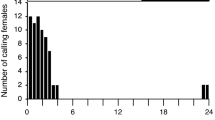Abstract
Sex pheromone investigations of the domesticated silkmoth, Bombyx mori (Lepidoptera: Bombycidae), helped elucidate the molecular and physiological fundamentals of chemical communication in moths, yet little is known about pheromone evolution in bombycid species. Therefore, we reexamined the sex pheromone communication in the wild silkmoth, Bombyx mandarina, which is considered ancestral to B. mori. Our investigations revealed that (a) B. mandarina females produce (E,Z)-10,12-hexadecadienol (bombykol), but not (E,Z)-10,12-hexadecadienal (bombykal) or (E,Z)-10,12-hexadecadienyl acetate (bombykyl acetate), which are pheromone components in other bombycid moths; (b) antennae of male B. mandarina respond strongly to bombykol as well as to bombykal and bombykyl acetate; and (c) bombykal and bombykyl acetate strongly inhibit attraction of B. mandarina males to bombykol in the field. The present study clarifies the evolution of pheromone communication in bombycid moths.



Similar content being viewed by others
References
Butenandt, A., Beckmann, R., Stamm, D., and Hecker, E. 1959. Über den Sexual-Lockstoff des Seidenspinners Bombyx mori—Reindarstellung und Konstitution. Z. Naturforsch. Pt. B 14:283–284.
Dai, X. J., Xu, S. F., Wang, M. Z., Zhu, Y. X., Tang, X. H., Zhu, J. W., Du, J. W., Dong, T. X., and Du, M. Z. 1988. E-10, Z-12-hexadecedienyl acetate: sex pheromone of the mulberry white caterpillar Rondotia menciana Moore (Lepidoptera, Bombycidae). Kexue Tongbao 33:1575–1576.
Daimon, T., Fujii, T., Yago, M., Hsu, Y.-F., Nakajima, Y., Fujii, T., Katsuma, S., Ishikawa, Y., and Shimada, T. 2012. Female sex pheromone and male behavioral responses of the bombycid moth Trilocha varians: comparison with those of the domesticated silkmoth Bombyx mori. Naturwissenschaften 99:207–215.
Fujii, T., Nakano, R., Takubo, Y., Qian, S., Yamakawa, R., Ando, T., and Ishikawa, Y. 2010. Female sex pheromone of a lichen moth Eilema japonica (Arctiidae, Lithosiinae): components and control of production. J. Insect Physiol. 56:1986–1991.
Goldsmith, M. R., Shimada, T., and Abe, H. 2004. The genetics and genomics of the silkworm, Bombyx mori. Annu. Rev. Entomol. 50:71–100.
Kaissling, K. E., Kasang, G., Bestmann, H. J., Stransky, W., and Vostrowsky, O. 1978. New pheromone of silkworm moth Bombyx mori—sensory pathway and behavioral effect. Naturwissenschaften 65:382–384.
Kuwahara, Y. 1984. Flight time of Bombyx mandarina males to a pheromone trap baited with bombykol. Appl. Entomol. Zool. 19:400–401.
Kuwahara, Y. and My-yen, L. T. 1979. Identification of bombykol in Bombyx mandarina females (Lepidoptera: Bombycidae). Appl. Entomol. Zool. 14:114–117.
Kuwahara, Y., Mori, N., Yamada, S., and Nemoto, T. 1983. Evaluation of bombykol as the sex pheromone of Bombyx mandarina (Lepidoptera: Bombycidae). Appl. Entomol. Zool. 19:265–267.
Lemaire, C. and Minet, J. 1998. The Bombycoidea and their relatives, pp. 321–353, in N. P. Kristensen (ed.), Lepidoptera, Moths and Butterflies Volume I: Evolution, Systematics, and Biogeography. Walter de Gruyter, Inc., Hawthorne, New York.
Matsumoto, S. 2010. Molecular mechanisms underlying sex pheromone production in moths. Biosci. Biotechnol. Biochem. 74:223–231.
Matsumoto, S., Hull, J. J., Ohnishi, A., Moto, K., and Fonagy, A. 2007. Molecular mechanisms underlying sex pheromone production in the silkmoth, Bombyx mori: characterization of the molecular components involved in bombykol biosynthesis. J. Insect Physiol. 53:752–759.
Moore, F. 1858. Bombyx huttoni, Westwood, pp. 379-381, in T. Horsfield and F. Moore (eds.). A catalogue of the lepidopterous insects in the museum of the Honourable East--India Company. Vol. 2. East-India Co.
Nakagawa, T., Sakurai, T., Nishioka, T., and Touhara, K. 2005. Insect sex-pheromone signals mediated by specific combinations of olfactory receptors. Science 307:1638–1642.
Sakurai, T., Nakagawa, T., Mitsuno, H., Mori, H., Endo, Y., Tanoue, S., Yasukochi, Y., Touhara, K., and Nishioka, T. 2004. Identification and functional characterization of a sex pheromone receptor in the silkmoth Bombyx mori. Proc. Natl. Acad. Sci. U. S. A. 101:16653–16658.
Sakurai, T., Mitsuno, H., Haupt, S. S., Uchino, K., Yokohari, F., Nishioka, T., Kobayashi, I., Sezutsu, H., Tamura, T., and Kanzaki, R. 2011. A single sex pheromone receptor determines chemical response specificity of sexual behavior in the silkmoth Bombyx mori. PLoS Genet. 7:e1002115.
Xia, Q., Guo, Y., Zhang, Z., Li, D., Xuan, Z., Li, Z., Dai, F., Li, Y., Cheng, D., Li, R., Cheng, T., Jiang, T., Becquet, C., Xu, X., Liu, C., Zha, X., Fan, W., Lin, Y., Shen, Y., Jiang, L., Jensen, J., Hellmann, I., Tang, S., Zhao, P., Xu, H., Yu, C., Zhang, G., Li, J., Cao, J., Liu, S., He, N., Zhou, Y., Liu, H., Zhao, J., Ye, C., Du, Z., Pan, G., Zhao, A., Shao, H., Zeng, W., Wu, P., Li, C., Pan, M., Yin, X., Wang, J., Zheng, H., Wang, W., Zhang, X., Li, S., Yang, H., Lu, C., Nielsen, R., Zhou, Z., and Xiang, Z. 2009. Complete resequencing of 40 genomes reveals domestication events and genes in silkworm (Bombyx). Science 326:433–436.
Zolotuhin, V. V. and Witt, T. J. 2009. The Bombycidae of Vietnam. Entomofauna Supplement 16:231–272.
Acknowledgements
We thank S. Namiki, T. Sakurai, and H. Mitsuno for helpful discussions; S. Matsuyama (Tsukuba University) and R. Kanzaki (University of Tokyo) for providing the bombykol standard; H. Hiyama for assisting with the field experiments in Fuchu; and M. Kawamoto and M. Suzuki for clerical assistance. We also thank members of the Institute for Sustainable Agro-ecosystem Services of the University of Tokyo for the management of mulberry fields in Tanashi. This work was supported by Grants-in-Aid for Scientific research (No. 22128004 to T.D., S.K., and T. Shimada; No. 21248006 to T.D., and T. Shimada; No. 23688008 to T.D.; and No. 23248008 to Y.I.) from MEXT/JSPS, Japan.
Author information
Authors and Affiliations
Corresponding author
Rights and permissions
About this article
Cite this article
Daimon, T., Fujii, T., Fujii, T. et al. Reinvestigation of the Sex Pheromone of the Wild Silkmoth Bombyx mandarina: The Effects of Bombykal and Bombykyl Acetate. J Chem Ecol 38, 1031–1035 (2012). https://doi.org/10.1007/s10886-012-0164-0
Received:
Revised:
Accepted:
Published:
Issue Date:
DOI: https://doi.org/10.1007/s10886-012-0164-0




